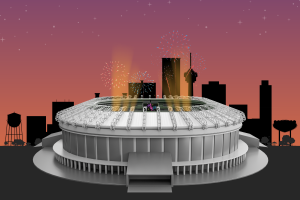In the early hours (US Central Standard Time) of January 31 will occur what has been termed a “super blue blood moon” or (because of the conjunction of the three descriptors) a “supermoon trilogy.”
These words are utterly meaningless.
A “supermoon” is a term for when the Moon appears (slightly) larger and brighter than average. The Moon’s orbit is not a perfect circle, and therefore a “supermoon” occurs when the Moon is closer to Earth and can be seen as a full moon. This is a perfectly natural phenomenon that changes virtually nothing on the Earth’s surface, aside from minor increases in tides. The media has in the past claimed that supermoons cause earthquakes; these claims persist despite having absolutely no scientific basis.
A “blue moon” is the term for when there are two full moons in one calendar month. The Moon’s orbital period is slightly shorter than the average calendar month; this means a “blue moon” occurs once every two and a half years or so. While this is a relatively rare event, it is entirely dependent on the way we as a society define our months. Societies that use different calendars, for instance, will have no such concept or see it entirely differently. Furthermore, thanks to time zones, other parts of the world will only see the Moon on the first of February, thus negating the “blue moon” entirely. Assigning meaning to this “blue moon” is not only entirely artificial, but it also implies a very America-centric mentality.
A “blood moon” is another term for a lunar eclipse; the Earth happens to be in the exact position to block plunging the Moon into the Earth’s shadow, blocking the Sun. Since the Moon’s normal silver radiance is reflected sunlight, the eclipsed Moon instead appears a deep red (caused by Earth’s atmospheric scattering). This is a pretty sight, to be sure, and it does remind one of the color of blood. But calling it a “blood moon” evokes feelings of danger, harkening back to a more ignorant past where the Moon’s motions were mysterious and feared. Unless this lunar eclipse causes the apocalypse, it is entirely misleading.
This whole set of terminology seems to exist only to generate media attention, and, to some degree, fear and anxiety. It is not too big a stretch to link them to the ongoing concern over fake news. They create a very false impression as to what this lunar eclipse actually is. Rather than trying to assign unnecessarily foreboding artificial significance to astronomical events, we should appreciate the magic and beauty of such events as they come.











